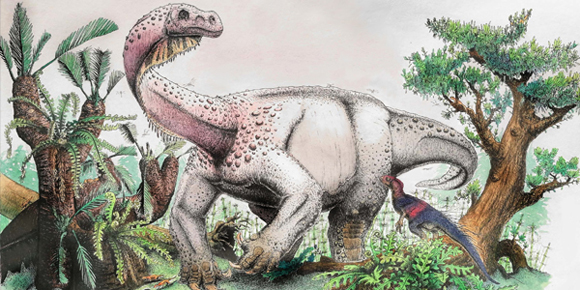Non-sauropod Sauropodomorphs – A Helpful Explanation
The phylogenetic relationship between the Sauropoda and the non-sauropod sauropodomorphs remains uncertain. The discovery of extremely large non-sauropod sauropodomorphs such as Lessemsaurus, Antetonitrus and Ingentia in the Southern Hemisphere demonstrates that some Late Triassic dinosaurs could rival the sauropods in terms of size. Further work is required to better understand the taxonomic relationship between the Sauropoda and other saurischian dinosaurs known from the Triassic and very Early Jurassic. These saurischian dinosaurs may or may not be closely related to the Sauropoda clade.
The first sauropodomorphs evolved in the Triassic. Initially, they were small and bipedal. It was thought that gigantism in this clade first evolved in the Early Jurassic and was linked to the Eusauropoda, dinosaurs which were obligate quadrupeds, with column-like legs and were graviportal (only capable of moving slowing). The paucity of the fossil record prevents a more complete understanding of sauropodomorph evolution. However, with the description of Ingentia prima (Apaldetti et al) in 2018 a new family of super-sized non-sauropod sauropodomorphs was established – the Lessemsauridae.
The Lessemsauridae (Non-sauropod Sauropodomorphs)
The Lessemsauridae attained an extremely large body size. These dinosaurs were much larger and heavier than the largest terrestrial mammals found today. They display rapid growth related to the seasonal availability of food. In addition, their skeletons demonstrate many anatomical traits associated with basal sauropodomorphs whilst lacking characteristics previously regarded as adaptations to gigantism.
Members of this family include Ingentia prima from the Quebrada del Barro Formation and Lessemsaurus sauropoides from the Los Colorados Formation (Argentina). In addition, the Early Jurassic sauropodomorph Antetonitrus ingenipes from the Elliot Formation of South Africa has been included. More recently other taxa from southern Africa have been added to this clade. Dinosaurs such as Meroktenos and Kholumolumo from Lesotho, and the huge Ledumahadi mafube from South Africa.

A life reconstruction of Ledumahadi mafube. Recently this dinosaur has been assigned to the Lessemsauridae clade.
Picture credit: Viktor Radermacher (Witwatersrand University)
A spokesperson from Everything Dinosaur commented:
“The old definitions of prosauropod and sauropod proved too simplistic. The evolution of super-sized, herbivorous dinosaurs in the Early Jurassic remains poorly defined. Hopefully, more complete fossil material from the Norian and Rhaetian faunal stages will help to clarify the taxonomy.”
The Everything Dinosaur website: Visit the Everything Dinosaur Website.

